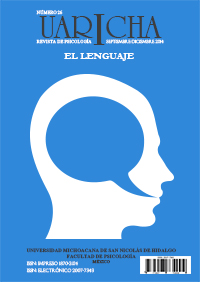The symbolic language in fairy tales
Main Article Content
Abstract
This paper presents an approach to understand the symbolic language of fairy tales. It refers to the symbolism and elements of some of the most famous stories, as well as the ways in which these stories can help children's psyche. Since fairy tales are written and designed in a metaphorical and symbolic language, are able to circumvent the highly structured intelligence and reach the unconscious to act on it, facilitating the child’s use of fantasy, identification with the characters and the subsequent management of conflicts, as well as allowing enrich and develop their psychological resourcesto resolve conflicts, and promote their social relationships and communication skills.
Article Details
Section

This work is licensed under a Creative Commons Attribution-NonCommercial-NoDerivatives 4.0 International License.
The authors have the right to ownership or copyright and they give to "Uaricha Psychology Magazine" the right to publish for the first time the article, as well as disclose and distribute it on the technological available media and through repositories.
Uaricha Psychology Magazine, is a quarterly publication, published by the Psychology College of the "Universidad Michoacana de San Nicolás de Hidalgo", Street Francisco Villa No. 450, Col. Dr. Miguel Silva, Morelia, Michoacán, P. C. 58110. Phone (+52) 443 312 9909, ext. 149, www.revistauaricha.umich.mx, uaricha.publicaciones@umich.mx. Responsible publisher: Roberto Oropeza Tena. Reserve of exclusive use rights No. 04-2013-070413365500-203, e-ISSN: 2007-7343, Granted by the National Institute Copyright. Responsible of the last update of this number, Computer center of the Psychology College, Ing. Erick Vidar Alva Rangel.
How to Cite
References
Bettelheim, B. (1977). Psicoanálisis de los cuentos de hadas. Barcelona: Crítica de Ideas.
Cashdan, S. (1999). La bruja debe morir. México: Editorial Debate.
Herrera. C. (2014). Los cuentos de hadas como herramienta de evaluación e intervención psicológica con orientación psicoanalítica en niños. (Tesis de licenciatura). Facultad de Psicología. México: UMSNH.
Mejía, M. (2010).Los personajes de los cuentos de hadas como elementos proyectivos de la psicodinamia del niño en la clínica psicoanalítica. (Tesis de Posgrado no publicada). Facultad de Psicología. México: UVAQ.
Montes, C., Campos, Y. (2011). El uso del cuento como estrategia para la mejora de la interacción social en niños y niñas. (Tesis de licenciatura) Facultad de Psicología. Morelia Michoacán: UMSNH.
Oñate, R., Ferrer, N. (2008). La mentira como cuento infantil. Una visión de la constelación familiar. Revista Aletheia, Psicología y Psicoanálisis, 27, 25-33.
Pacheco, M., Orozco, M., Pavón, D. (2012). El drama de la devoración en el relato infantil.Revista de educación y desarrollo. México, 22, 13-24.
Padilla, M. (2003). Psicoterapia de juego. México: Plaza y Valdez Editores. IIPCS.
Peña, M. (1994). Alas para la infancia. Fundamentos de literatura infantil. Santiago de Chile: Editorial universitaria.
Ryken, L., Lamp, M. (2006). Las Crónicas de Narnia: Guía a El león, la bruja y el armario.Barcelona: Publicaciones Andamios.
Sotelo, C. (2008). La voluntad en los cuentos infantiles. Revista Alétheia Psicología y Psicoanálisis. 27, 135-140.
Volosky, L. (1995). Poder y Magia del cuento infantil. Santiago de Chile: Editorial Universitaria.
Walter, E. (2001). Leoncito Probo: Un Cuento de Hadas Arquetípico. Estudio Preliminar Sobre los Cuentos de Hadas y el Inconsciente Colectivo. Buenos Aires: Libros en Red.

